英语中常见的八种基本时态
中考英语八种时态归纳

中考英语八种时态归纳时态是英语语法中一个非常重要的概念,它直接影响着句子的表达方式和意义。
对于中考英语考试来说,掌握八种基本时态是至关重要的。
本文将对这八种时态进行归纳总结,帮助同学们更好地理解和运用。
一、一般现在时(Simple Present Tense)一般现在时表示经常发生的情况、客观真理、习惯性动作和现阶段的状态。
例句:I play basketball every weekend.(我每个周末打篮球。
)The sun rises in the east.(太阳从东方升起。
)二、一般过去时(Simple Past Tense)一般过去时表示过去某个时间点发生的动作或存在的状态。
例句:I visited my grandparents last summer.(我去年夏天拜访了我的祖父母。
)She lived in London when she was young.(她年轻时住在伦敦。
)三、一般将来时(Simple Future Tense)一般将来时表示将来某个时间点将要发生的动作或存在的状态。
例句:We will have a party next weekend.(我们下个周末要开派对。
)He will be a doctor when he grows up.(他长大后会成为一名医生。
)四、现在进行时(Present Continuous Tense)现在进行时表示说话时正在进行的动作。
例句:They are studying in the library now.(他们现在正在图书馆学习。
)I am not feeling well today.(我今天感觉不舒服。
)五、过去进行时(Past Continuous Tense)过去进行时表示过去某个时间点正在进行的动作。
例句:She was watching TV when I called her.(我打电话给她时,她正在看电视。
英语中常见的八种基本时态
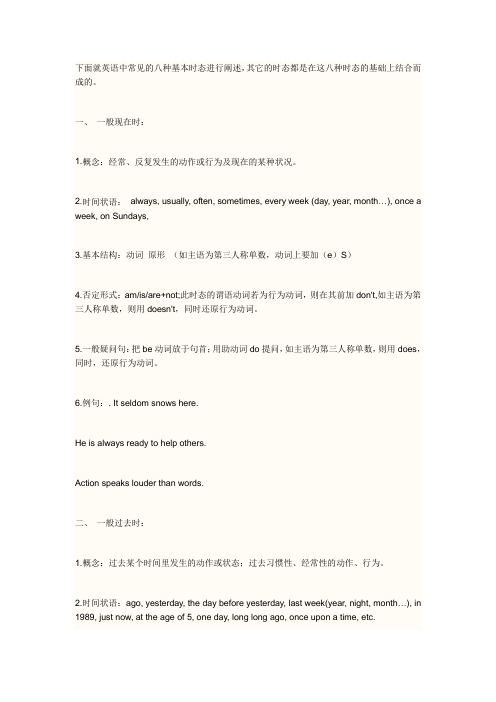
下面就英语中常见的八种基本时态进行阐述,其它的时态都是在这八种时态的基础上结合而成的。
一、一般现在时:1.概念:经常、反复发生的动作或行为及现在的某种状况。
2.时间状语:always, usually, often, sometimes, every week (day, year, month…), once a week, on Sundays,3.基本结构:动词原形(如主语为第三人称单数,动词上要加(e)S)4.否定形式:am/is/are+not;此时态的谓语动词若为行为动词,则在其前加don't,如主语为第三人称单数,则用doesn't,同时还原行为动词。
5.一般疑问句:把be动词放于句首;用助动词do提问,如主语为第三人称单数,则用does,同时,还原行为动词。
6.例句:. It seldom snows here.He is always ready to help others.Action speaks louder than words.二、一般过去时:1.概念:过去某个时间里发生的动作或状态;过去习惯性、经常性的动作、行为。
2.时间状语:ago, yesterday, the day before yesterday, last week(year, night, month…), in 1989, just now, at the age of 5, one day, long long ago, once upon a time, etc.3.基本结构:be动词;行为动词4.否定形式:was/were+not;在行为动词前加didn't,同时还原行为动词。
5.一般疑问句:was或were放于句首;用助动词do的过去式did 提问,同时还原行为动词。
6.例句:She often came to help us in those days.I didn't know you were so busy.三、现在进行时:1.概念:表示现阶段或说话时正在进行的动作及行为。
初中英语时态8种基本时态讲解
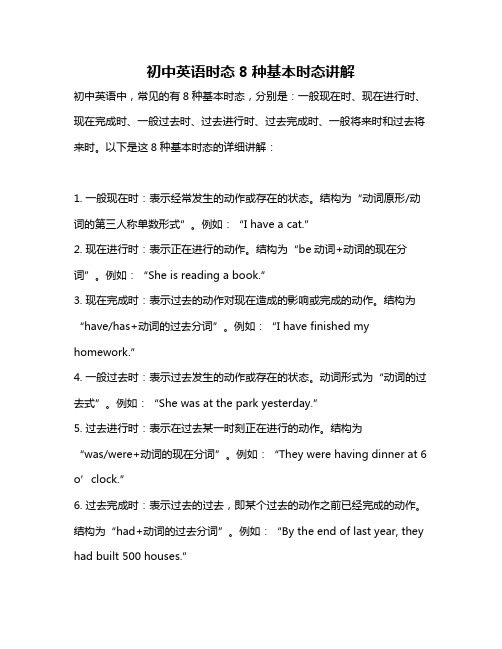
初中英语时态8种基本时态讲解初中英语中,常见的有8种基本时态,分别是:一般现在时、现在进行时、现在完成时、一般过去时、过去进行时、过去完成时、一般将来时和过去将来时。
以下是这8种基本时态的详细讲解:1. 一般现在时:表示经常发生的动作或存在的状态。
结构为“动词原形/动词的第三人称单数形式”。
例如:“I have a cat.”2. 现在进行时:表示正在进行的动作。
结构为“be动词+动词的现在分词”。
例如:“She is reading a book.”3. 现在完成时:表示过去的动作对现在造成的影响或完成的动作。
结构为“have/has+动词的过去分词”。
例如:“I have finished my homework.”4. 一般过去时:表示过去发生的动作或存在的状态。
动词形式为“动词的过去式”。
例如:“She was at the park yesterday.”5. 过去进行时:表示在过去某一时刻正在进行的动作。
结构为“was/were+动词的现在分词”。
例如:“They were having dinner at 6 o’clock.”6. 过去完成时:表示过去的过去,即某个过去的动作之前已经完成的动作。
结构为“had+动词的过去分词”。
例如:“By the end of last year, they had built 500 houses.”7. 一般将来时:表示将来要发生的动作或存在的状态。
结构为“will+动词原形”或“am/is/are going to+动词原形”。
例如:“We will visit the museum next week.”8. 过去将来时:表示从过去的某一时刻看,将来要发生的动作或存在的状态。
结构为“would+动词原形”或“was/were going to+动词原形”。
例如:“He said he would come back soon.”以上就是初中英语8种基本时态的讲解,希望对你有帮助!。
英语八大时态总结
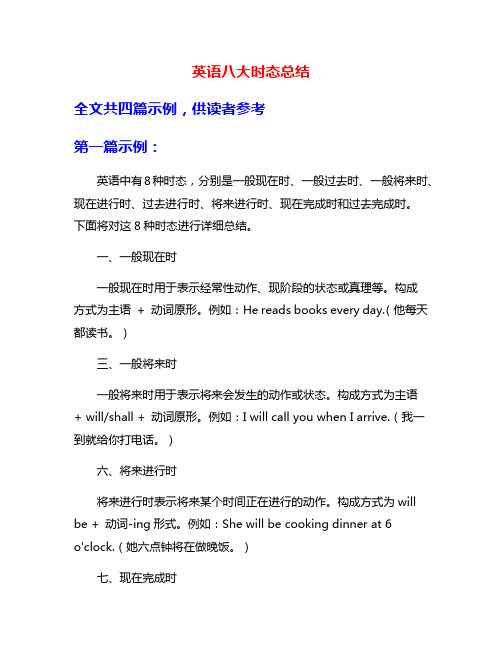
英语八大时态总结全文共四篇示例,供读者参考第一篇示例:英语中有8种时态,分别是一般现在时、一般过去时、一般将来时、现在进行时、过去进行时、将来进行时、现在完成时和过去完成时。
下面将对这8种时态进行详细总结。
一、一般现在时一般现在时用于表示经常性动作、现阶段的状态或真理等。
构成方式为主语+ 动词原形。
例如:He reads books every day.(他每天都读书。
)三、一般将来时一般将来时用于表示将来会发生的动作或状态。
构成方式为主语+ will/shall + 动词原形。
例如:I will call you when I arrive.(我一到就给你打电话。
)六、将来进行时将来进行时表示将来某个时间正在进行的动作。
构成方式为will be + 动词-ing形式。
例如:She will be cooking dinner at 6o'clock.(她六点钟将在做晚饭。
)七、现在完成时现在完成时用于表示过去某个时间开始的动作一直持续到现在,并可能继续发生。
构成方式为主语+ have/has + 过去分词。
例如:He has lived here for 5 years.(他在这里住了5年了。
)总结:1. 一般现在时表示经常性动作、现阶段的状态或真理。
2. 一般过去时表示过去某个时间发生的动作或状态。
3. 一般将来时表示将来会发生的动作或状态。
4. 现在进行时表示现在进行的动作或状态。
5. 过去进行时表示过去某个时间正在进行的动作。
6. 将来进行时表示将来某个时间将会进行的动作。
7. 现在完成时表示过去某个时间开始的动作一直持续到现在。
8. 过去完成时表示过去某个时间之前发生的动作。
掌握这8种时态的用法及构成方式对于学习英语语法和提高英语水平非常重要。
希望以上总结对您有所帮助。
第二篇示例:英语八大时态是学习英语语法非常重要的内容之一,掌握好各种时态的用法可以帮助我们更准确地表达自己的意思。
(完整版)英语中八种常见时态常用时间状语归纳

英语中八种常见时态常用时间状语归纳一、一般现在时1。
概念:表示现阶段经常发生的动作或现在的某种状况,也表示客观事实、客观规律或客观真理。
谓语动词要用原形,主语是第三人称时,谓语动词要用第三人称单数形式。
2. 常见时间状语标志:always, often, sometimes, usually, every day, on Sundays, once a day / week / month等。
例如:I do some exercise every day. 我每天做一些锻炼。
She knows French and German besides English。
除英语外,她还懂法语和德语。
The sun rises in the east. 太阳从东边升起.二、一般将来时1。
概念:表示将来发生的动作或存在的状态,以及打算、计划或准备做某事。
2。
常见时间状语标志:tomorrow, the day after tomorrow,next day / week / month / year…, this week / month / year, soon, in + 时间状语(如in one hour / in a few minutes等),in the future,in future等。
例如:I’ll take you there tomorrow. 我明天带你去那儿。
Next month we will have our school open day。
下个月我们将迎来学校开放日。
The Talent Show is coming in two weeks’ time. 新秀选拔演出还有两周时间就要到了。
三、一般过去时1。
概念:表示在过去的某个时间发生的动作或存在的状态,也表示过去习惯性、经常性的动作。
谓语动词要用过去时。
2。
常见时间状语标志:yesterday, the day before yesterday, last night / week / month,时间词+ ago (如three days ago), in / on + 过去的时间词(如in 2010), just now, at that time, in those days, one day, long long time ago, once upon a time等.例如:Two years ago she bought an expensive mountain bike. 两年前,她买了一辆昂贵的山地自行车。
(完整版)初中英语八种时态总结归纳

初中英语八种时态总结归纳一、一般现在时:概念:经常、反复发生的动作或行为及现在的某种状况。
时间状语:often,usually,always,sometimes,every week(day,year,month...),once a week,on sundays,etc.基本结构:①be动词;②行为动词否定形式:①am /is /are +not;②此时态的谓语动词若为行为动词,则在其前加don't,如主语为第三人称单数,则用doesn't,同时还原行为动词。
一般疑问句:①把be动词放于句首;②用助动词do提问,如主语为第三人称单数,则用does,同时,还原行为动词。
二、一般过去时:概念:过去某个时间里发生的动作或状态;过去习惯性、经常性的动作、行为。
时间状语:ago,yesterday,the day before yesterday,last week(year,night,month...),in 1989,just now,at the age of 5,one day,long long ago,once upon a time,etc.基本结构:①be动词;②行为动词否定形式:① was/were +not;②在行为动词前加didn't,同时还原行为动词。
一般疑问句:①was或were放在句首;②用助动词do的过去式did提问,同时还原行为动词。
三、现在进行时:概念:表示现阶段或说话时正在进行的动作及行为。
时间状语:now,at this time,these days,etc.基本结构:am/is/are +doing否定形式:am/is/are +not+doing一般疑问句:把be动词放在句首四、过去进行时:概念:表示过去某段时间或某一时刻正在发生或进行的行为或动作。
时间状语:at this time yesterday,at that time或以when引导的谓语动词是一般过去时的时间状语等。
全面解析初中英语八种时态(纯干货)

全面解析初中英语八种时态!时态是英语学习中一个至关重要的内容,大家在实际运用英语时,往往对时态倍感棘手,下面我们就归纳复习一下这几种时态。
英语八种时态一、一般现在时概念:经常、反复发生的动作或行为及现在的某种状况。
时间状语:always, usually, often, sometimes, every week (day, year, month…), once a week, on Sundays, etc.基本结构:①be动词;②行为动词否定形式:①am/is/are+not;②此时态的谓语动词若为行为动词,则在其前加don't,如主语为第三人称单数,则用doesn't,同时还原行为动词。
一般疑问句:①把be动词放于句首;②用助动词do提问,如主语为第三人称单数,则用does,同时,还原行为动词。
二、一般过去时概念:过去某个时间里发生的动作或状态;过去习惯性、经常性的动作、行为。
时间状语:ago, yesterday, the day before yesterday, last week(year, night, month…), in 1989, just now, at the age of 5, one day, long long ago, once upon a time, etc.基本结构:①be动词;②行为动词否定形式:①was/were+not;②在行为动词前加didn't,同时还原行为动词。
一般疑问句:①was或were放于句首;②用助动词do的过去式did 提问,同时还原行为动词。
三、现在进行时概念:表示现阶段或说话时正在进行的动作及行为。
时间状语:now, at this time, these days, etc.基本结构:am/is/are+doing否定形式:am/is/are+not+doing.一般疑问句:把be动词放于句首。
四、过去进行时概念:表示过去某段时间或某一时刻正在发生或进行的行为或动作。
初中英语时态8种基本时态归纳
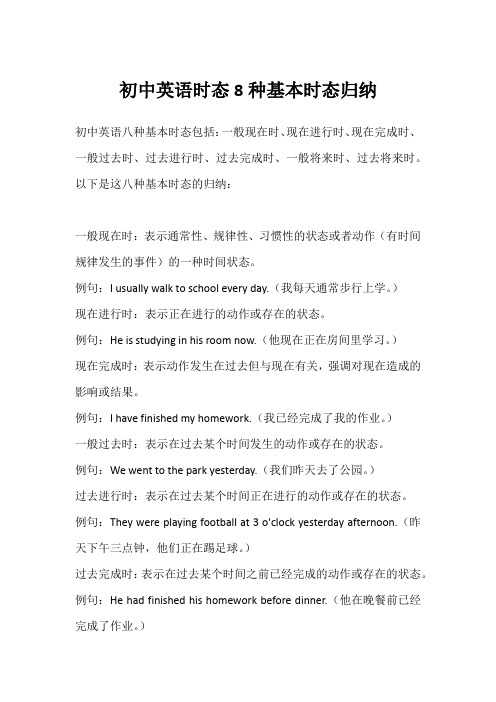
初中英语时态8种基本时态归纳初中英语八种基本时态包括:一般现在时、现在进行时、现在完成时、一般过去时、过去进行时、过去完成时、一般将来时、过去将来时。
以下是这八种基本时态的归纳:一般现在时:表示通常性、规律性、习惯性的状态或者动作(有时间规律发生的事件)的一种时间状态。
例句:I usually walk to school every day.(我每天通常步行上学。
)现在进行时:表示正在进行的动作或存在的状态。
例句:He is studying in his room now.(他现在正在房间里学习。
)现在完成时:表示动作发生在过去但与现在有关,强调对现在造成的影响或结果。
例句:I have finished my homework.(我已经完成了我的作业。
)一般过去时:表示在过去某个时间发生的动作或存在的状态。
例句:We went to the park yesterday.(我们昨天去了公园。
)过去进行时:表示在过去某个时间正在进行的动作或存在的状态。
例句:They were playing football at 3 o'clock yesterday afternoon.(昨天下午三点钟,他们正在踢足球。
)过去完成时:表示在过去某个时间之前已经完成的动作或存在的状态。
例句:He had finished his homework before dinner.(他在晚餐前已经完成了作业。
)一般将来时:表示将来的动作或状态,通常与“will”或“shall”连用。
例句:It will rain tomorrow.(明天会下雨。
)过去将来时:表示在过去某个时间之后将要发生的动作或存在的状态,通常与“would”连用。
例句:He said he would come to see me the next day.(他说他第二天会来看我。
)。
初中英语基础语法必会八种基本时态

初中英语基础语法必会八种基本时态1. 一般现在时概念:表示经常发生的动作或经常存在的状态。
常和always,often,usually,sometimes,every day等表时间的状语连用。
如:1)I go to school every day . 我每天都去学校。
(表经常)2)He is always like that . 他总是那样。
(表状态)构成:1)主语+ be (am / are / is )+……2)主语+ 实义动词/三单动词+…2.一般过去时概念:1)表示过去某个时间发生的动作或存在的状态。
常和表示过去的时间状语连用. 如:yesterday,last week,in 1998,two days ago等。
如:I went to a movie yesterday. 我昨天去看了一场电影。
2)也可表示过去经常或反复发生的动作。
如:He always went to work by bike last week.构成:1)主语+ be (was / were)+……2)主语+实义动词过去式3. 现在进行时概念:表示现在(说话瞬间)正在进行或发生的动作。
如:He is singing.They are watching TV now.构成:主语+助动词be(am/are/is)+动词-ing形式构成。
4. 过去进行时概念:表示过去某一时刻或某一段时间正在进行的动作. 这一特定的过去时间除了有上下文暗示外,一般用时间状语来表示。
如:1)——What were you doing?——I was jumping.2)——What was the boy doing when the UFO arrived?——He was sleeping.构成:主语+助动词be(was/were)+动词-ing形式构成。
5. 一般将来时概念:表示将来某个时间要发生的动作或存在的状态,也表示将来经常或反复发生的动作,常与表示将来的时间状语连用,如:tomorrow,next week,next year,in the future等.如:He will go shopping tomorrow.They are going to play basketball next week.构成:1)主语+助动词will +动原+…2)主语+ be going to +动原+….6. 过去将来时概念:表示在过去将来的某一时间发生的动作或存在的状态。
英语八大时态总结表 8种基本时态结构句型
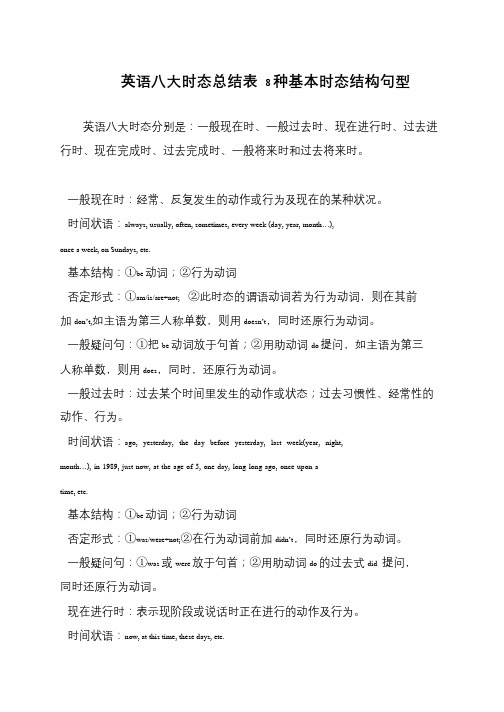
英语八大时态总结表8 种基本时态结构句型英语八大时态分别是:一般现在时、一般过去时、现在进行时、过去进行时、现在完成时、过去完成时、一般将来时和过去将来时。
一般现在时:经常、反复发生的动作或行为及现在的某种状况。
时间状语:always, usually, often, sometimes, every week (day, year, month…),once a week, on Sundays, etc.基本结构:①be 动词;②行为动词否定形式:①am/is/are+not; ②此时态的谓语动词若为行为动词,则在其前加don’t,如主语为第三人称单数,则用doesn’t,同时还原行为动词。
一般疑问句:①把be 动词放于句首;②用助动词do 提问,如主语为第三人称单数,则用does,同时,还原行为动词。
一般过去时:过去某个时间里发生的动作或状态;过去习惯性、经常性的动作、行为。
时间状语:ago, yesterday, the day before yesterday, last week(year, night,month…), in 1989, just now, at the age of 5, one day, long long ago, once upon atime, etc.基本结构:①be 动词;②行为动词否定形式:①was/were+not;②在行为动词前加didn’t,同时还原行为动词。
一般疑问句:①was 或were 放于句首;②用助动词do 的过去式did 提问,同时还原行为动词。
现在进行时:表示现阶段或说话时正在进行的动作及行为。
时间状语:now, at this time, these days, etc.。
英语语中常见的时态有8种

语中常见的时态有8种--- 一般现在时/一般过去时;现在进行时/过去进行时;一般将来时/过去将来时;现在完成时/过去完成时。
另外还有现在完成进行时/过去完成进行时,将来完成时,将来进行时。
一关于一般现在时(第三人称动词后加” s” 或“es” )(1)表示经常性、习惯性动作。
(2)普遍真理、自然现象,谚语、报刊标题等(3)代替将来时(主从句均为将来时时,代替从句中的将来时)(4)以here ,there 开头的句子中,动词go come 等用现在时代替进行时Here comes the bus. There goes the bell.二关于一般过去时(谓语构成: V +ed, 注意不规则动词的构成)(1)表过去经常性、习惯性动。
(注意比较would do/ used to do )She often came to visit us when she was there.Whenever I went to Beijing, he would come to guide me.(2) 过去某一时刻发生的动作。
三关于现在进行时(am/is/are + ving)(1) 表示此时此刻或现阶段正在进行的动作。
How are getting along with your studies these days?More and more people are giving up smoking.(2) 表将来,用于从句中,可代替将来时。
常用于瞬间动词,如come, go, leave, arrive, die 等,常表示渐进或安排要进行的动作。
If she is doing her homew ork, don’t interrupt her.He is dying.注意:系动词look, feel, taste, smell, sound, prove,等及心理活动的动词want, mean, mind, hope, understand, know, like, dislike ,love, prefer, hate ,doubt等一般不用进行时。
英语常见时态语法结构

英语常见时态语法结构英语的八大时态:一般现在时:主语+do/does;一般过去时:主语+did;一般将来时:will do/;一般将来时:will do/;现在进行时:主语+am/is/are doing等。
一、一般现在时:主语+do/does(现在分词)基本结构:①动词原形②主语第三人称单数:动词原形+s/es三种常考基本用法:1、经常性和习惯性动作2、客观事实和普遍真理3、在时间状语从句及条件状语从句中,一般现在表将来常见时间状语:always, usually, often, sometimes, every day, on Sundays, at weekends, once a week, twice a month, etc.二、一般过去时:主语+did基本结构:动词的过去式基本用法:1、过去某个时间里发生的动作或状态2、过去习惯性、经常性的动作常见时间状语:ago, yesterday, the day before yesterday, last week (year, night, month…), in 1986, just now, at the age of 10, at that time, once upon a time, etc.三、一般将来时:will do/基本结构:①am/is/are/going to + do;②will/shall + do.基本用法:1、(人)计划打算做某事2、(事)即将发生will/shall do1、将来的动作和状态(相对较长远)2、礼貌询问、客气邀请3、意愿常见时间状语:tomorrow, next day (week, month, year…), soon, the day after tomorrow, in+时间段(格外注意),etc.四、现在进行时:主语+am/is/are doing基本结构:am/is/are+现在分词基本用法:1、此时此刻正在进行的动作2、现阶段正在进行的动作常见时间状语:now, at this time, these days, etc.五、过去进行时:was/were doing基本结构:was/were+现在分词基本用法:1、过去某时刻正在进行的动作2、过去某时段正在进行的动作常见时间状语:at this time yesterday, at that time或以when引导的谓语动词是一般过去时的时间状语等.六、过去将来时:was/were to /would do基本结构:①was/were/going to + do;②would/should + do.基本用法:从过去时间点看将来,常用于宾语从句中.常见时间状语:the next day (morning, year…), the following month (week…), etc.七、现在完成时:have/has done基本结构:have/has + 过去分词基本用法:1、过去发生的动作对现在造成的影响或结果2、过去已经开始,持续到现在的动作或状态常见时间状语:recently, lately, so far, up to now, since+时间点,for+时间段, in the past few years, etc.八、过去完成时:had done基本结构:had + 过去分词基本用法:以过去某个时间为标准,在此以前发生的动作或行为,即"过去的过去".常见时间状语:before, after, by the end of last year(month…),etc.。
英语八种时态的构成及用法

英语八种时态的构成及用法英语一共有12种时态,包括4种基本时态(简单现在时、一般过去时、一般将来时、现在进行时)和8种复合时态(现在完成时、过去完成时、将来完成时、现在完成进行时、过去完成进行时、将来完成进行时、过去进行时、过去将来进行时)。
下面是英语八种基本时态的构成和用法:1. 简单现在时(Simple Present Tense):构成:主语 + 动词原形(第三人称单数要加-s或-es)用法:1) 表示经常性或习惯性动作、真理或普遍事实等。
例句:I play basketball every Saturday.(我每个星期六打篮球。
)2) 表示现阶段,比如现在进行时。
例句:She is sleeping now.(她现在正在睡觉。
)2. 一般过去时(Simple Past Tense):构成:主语 + 动词过去式用法:1) 表示过去某个时间或某个时间段的动作或状态。
例句:I studied English yesterday.(我昨天学习了英语。
)2) 表示过去的经历或习惯。
例句:When I was young, I often went swimming.(我小时候经常去游泳。
)3. 一般将来时(Simple Future Tense):构成:主语 + will + 动词原形用法:1) 表示将来的动作、计划、意愿或预测等。
例句:I will go to the movies tomorrow.(我明天将要去看电影。
)2) 表示征求意见或请求等。
例句:Will you help me with this?(你能帮我一下吗?)4. 现在进行时(Present Continuous Tense):构成:主语 + am/is/are + 动词-ing形式用法:1) 表示正在进行的动作或事情。
例句:She is studying in the library at the moment.(她现在正在图书馆学习。
初中英语的八大时态

初中英语的八大时态时态无疑是学校英语最重要的语法内容,学好时态基本就拿下了语法的半壁江山。
,我在这里整理了学校英语的八大时态,盼望能关心到大家。
一般现在时一1. 概念:常常、反复发生的动作或行为及现在的某种状况。
2. 基本结构:①is/am/are;②do/does否定形式:①am/is/are+not;②此时态的谓语动词若为行为动词,则在其前加dont,如主语为第三人称单数,则用doesnt,同时还原行为动词。
3. 一般疑问句:①把is/am/are动词放于句首;②用助动词do 提问,如主语为第三人称单数,则用does,同时,还原行为动词。
4. 用法1) 常常性或习惯性的动作,常与表示频度的时间状语连用。
例如:I leave home for school at 7 every morning. 每天早上我七点离开家。
2) 客观真理,客观存在,科学事实。
例如:The earth moves around the sun. 地球绕太阳转动。
Shanghai lies in the east ofChina. 上海位于中国东部。
3) 表示格言或警句。
例如:Pride goes before a fall. 骄者必败。
留意:此用法假如消失在宾语从句中,即使主句是过去时,从句谓语也要用一般现在时。
例如:Columbus proved that the earth is round. 哥伦布证明了地球是圆的。
4) 现在时刻的状态、力量、性格、共性。
例如:I dont want so much. 我不要那么多。
Ann writes good English but does not speak well.安英语写得不错,讲的可不行。
5) 一般现在时表示将来含义a. 下列动词come, go, arrive, leave, start, begin, return的一般现在时可以表示将来,主要用来表示在时间上已确定或支配好的事情。
八大时态的结构表

八大时态的结构表英语的八大时态有:一般现在时(主语+do/does)、一般过去时(主语+did)、一般将来时、现在进行时、过去进行时、过去将来时、现在完成时和过去完成时。
一、一般现在时:主语+do/does(现在分词)基本结构:①动词原形②主语第三人称单数:动词原形+s/es三种常考基本用法:1、经常性和习惯性动作2、客观事实和普遍真理3、在时间状语从句及条件状语从句中,一般现在表将来常见时间状语:always, usually, often, sometimes, every day, on Sundays, at weekends, once a week, twice a month, etc.二、一般过去时:主语+did基本结构:动词的过去式基本用法:1、过去某个时间里发生的动作或状态2、过去习惯性、经常性的动作常见时间状语:ago, yesterday, the day before yesterday, last week (year, night, month), in 1986, just now, at the age of 10, at that time, once upona time, etc.三、一般将来时:will do/基本结构:①am/is/are/going to + do;②will/shall + do.基本用法:1、(人)计划打算做某事2、(事)即将发生will/shall do1、将来的动作和状态(相对较长远)2、礼貌询问、客气邀请3、意愿常见时间状语:tomorrow, next day (week, month, year), soon, the day after tomorrow, in+时间段(格外注意),etc.四、现在进行时:主语+am/is/are doing基本结构:am/is/are+现在分词基本用法:1、此时此刻正在进行的动作2、现阶段正在进行的动作常见时间状语:now, at this time, these days, etc.五、过去进行时:was/were doing基本结构:was/were+现在分词基本用法:1、过去某时刻正在进行的动作2、过去某时段正在进行的动作常见时间状语:at this time yesterday, at that time或以when引导的谓语动词是一般过去时的时间状语等.六、过去将来时:was/were to /would do基本结构:①was/were/going to + do;②would/should + do.基本用法:从过去时间点看将来,常用于宾语从句中.常见时间状语:the next day (morning, year), the following month (week), etc.七、现在完成时:have/has done基本结构:have/has + 过去分词基本用法:1、过去发生的动作对现在造成的影响或结果2、过去已经开始,持续到现在的动作或状态常见时间状语:recently, lately, so far, up to now, since+时间点,for+时间段, in the past few years, etc.八、过去完成时:had done基本结构:had + 过去分词基本用法:以过去某个时间为标准,在此以前发生的动作或行为,即过去的过去.常见时间状语:before, after, by the end of last year(month),etc.。
英语时态8种基本时态结构

英语时态8种基本时态结构英语中有8种基本时态结构:简单现在时、进行时、完成时、过去时、过去进行时、过去完成时、将来时和将来完成时。
1. 简单现在时 (Simple Present)简单现在时用来表示经常性、习惯性或普遍真相的动作或状态。
在句子中,主语是第三人称单数,谓语动词要加上“-s”或“-es”。
例如:- He goes to work every day. (他每天上班。
)- Cats like to chase mice. (猫喜欢追逐老鼠。
)- The sun rises in the east. (太阳从东方升起。
)2. 进行时 (Present Continuous)进行时用来表示目前正在进行的动作或状态。
在句子中,谓语动词由“be”动词的不同形式加上动词的现在分词构成。
例如:- She is watching TV now. (她现在正在看电视。
)- We are studying for the exam. (我们正在为考试学习。
)- They are playing soccer in the park. (他们在公园里踢足球。
)3. 完成时 (Present Perfect)完成时用来表示过去已经发生但与现在相关的动作或状态。
在句子中,谓语动词由“have/has”+过去分词构成。
例如:- I have finished my homework. (我已经完成作业。
)- She has lived in London for five years. (她在伦敦住了五年。
)- They have traveled to many countries. (他们去过许多国家。
)4. 过去时 (Simple Past)过去时用来表示过去一些时间发生的动作或状态。
在句子中,谓语动词用动词的过去式形式。
例如:- I visited my grandparents last weekend. (上周末我去看望了我的祖父母。
(完整版)人教版初中英语八大时态详解

人教版初中英语八大时态详解英语的时态(tense)是一种动词形式,不同的时态用以表示不同的时间与方式。
下面就英语中常见的八种基本时态进行阐述,其它的时态都是在这八种时态的基础上结合而成的。
一、一般现在时:1.概念:经常、反复发生的动作或行为及现在的某种状况。
2.时间状语:always, usually, often, sometimes, every week (day, year, month...), once a week, on Sundays,3.基本结构:动词原形(如主语为第三人称单数,动词上要加(e)S)4.否定形式:am/is/are+not;此时态的谓语动词若为行为动词,则在其前加don't,如主语为第三人称单数,则用doesn't,通常还原行为动词。
5.一般疑问句:把be动词放于句首;用助动词do提问,如主语为第三人称单数,则用does,同时,还原行为动词。
6.例句:It seldom snows here.He is always ready to help others.Action speaks louder than words.二、一般过去时:1.概念:过去某个时间里发生的动作或状态;过去习惯性、经常性的动作、行为。
2.时间状语:ago, yesterday, the day before yesterday, last week(year, night, month…), in 1989, just now, at the age of 5, one day, long long ago, once upon a time, etc.3.基本结构:be动词;行为动词4.否定形式:was/were+not;在行为动词前加didn't,同时还原行为动词。
5.一般疑问句:was或were放于句首;用助动词do的过去式did 提问,同时还原行为动词。
6.例句:She often came to help us in those days.I didn't know you were so busy.三、现在进行时:1.概念:表示现阶段或说话时正在进行的动作及行为。
(完整版)初中英语八种基本时态总结
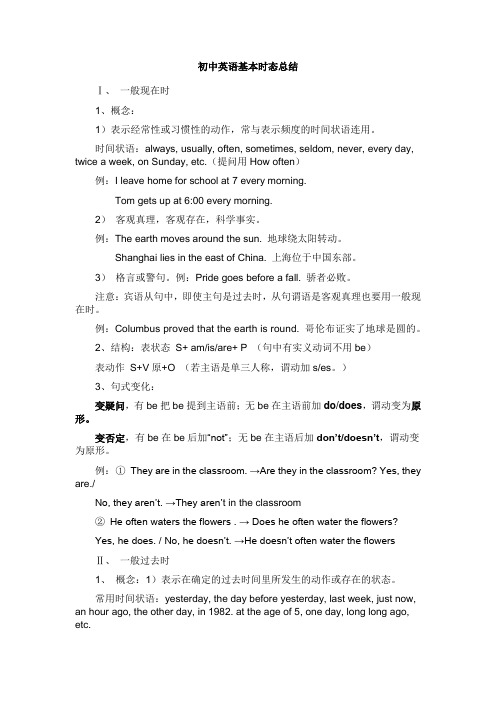
初中英语基本时态总结Ⅰ、一般现在时1、概念:1)表示经常性或习惯性的动作,常与表示频度的时间状语连用。
时间状语:always, usually, often, sometimes, seldom, never, every day, twice a week, on Sunday, etc.(提问用How often)例:I leave home for school at 7 every morning.Tom gets up at 6:00 every morning.2)客观真理,客观存在,科学事实。
例:The earth moves around the sun. 地球绕太阳转动。
Shanghai lies in the east of China. 上海位于中国东部。
3)格言或警句。
例:Pride goes before a fall. 骄者必败。
注意:宾语从句中,即使主句是过去时,从句谓语是客观真理也要用一般现在时。
例:Columbus proved that the earth is round. 哥伦布证实了地球是圆的。
2、结构:表状态S+ am/is/are+ P (句中有实义动词不用be)表动作S+V原+O (若主语是单三人称,谓动加s/es。
)3、句式变化:变疑问,有be把be提到主语前;无be在主语前加do/does,谓动变为原形。
变否定,有be在be后加“not”;无be在主语后加don’t/doesn’t,谓动变为原形。
例:①They are in the classroom. →Are they in the classroom? Yes, they are./No, they aren’t. →They aren’t in the classroom②He often waters the flowers . → Does he often water the flowers?Yes, he does. / No, he doesn’t. →He doesn’t often water the flowersⅡ、一般过去时1、概念:1)表示在确定的过去时间里所发生的动作或存在的状态。
英语八大时态的定义

英语时态8种基本时态有:一般现在时、一般现过去时、现在进行时、过去进行时、现在完成时、过去完成时、—般将来时、过去将来时。
一般现在时一般现在时,是一种英语语法形式。
表示通常性、规律性、习惯性、真理性(即事实)的动作或状态,或者动作有时间规律发生的事件的一种时间状态。
在英语语法中,“时“指动作发生的时间,”态“指动作的样子和状态。
一般现过去时一般过去将来时表示从过去的某一时间来看将来要发生的动作或呈现的状态。
在英语时态中,“时“指动作发生的时间,”态“指动作的样子和状态。
一般过去将来时的出发点是过去,即从过去某一时刻看以后要发生的动作或状态。
现在进行时现在进行时,专业术语,是英语的一种时态,表示现在进行的动作或存在的状态。
在英语时态中,“时“指动作发生的时间,”态“指动作的样子和状态。
现在进行时表示动作发生的时间是“现在”,动作目前的状态是“正在进行中”。
过去进行时过去进行时,表示过去在某一时间段或某一段时间内正在发生或进行的动作或状态。
在英语时态中,“时“指动作发生的时间,”态“指动作的样子和状态。
现在完成时由“have/has+过去分词”构成,主要有两个含义:表示动作发生在过去,但与现在的情况有联系,有时无时间状语,有时和一些表示不确定的过去时间状语连用,如:many times,just,yet,ever,never,already,before,so far, by now等连用。
过去完成时过去完成时:表示过去某一时间或动作以前已经发生或完成了的动作,对过去的某一点造成的某种影响或是结果,用来指在另一个过去行动之前就已经完成了的事件。
在英语时态中,“时“指动作发生的时间,”态“指动作的样子和状态。
它表示动作发生的时间是“过去的过去”,侧重事情的结果。
—般将来时一般将来时表示将来某一时段的动作或状态,或将来某一段时间内经常的动作或状态。
在英语时态中,“时“指动作发生的时间,”态“指动作的样子和状态。
- 1、下载文档前请自行甄别文档内容的完整性,平台不提供额外的编辑、内容补充、找答案等附加服务。
- 2、"仅部分预览"的文档,不可在线预览部分如存在完整性等问题,可反馈申请退款(可完整预览的文档不适用该条件!)。
- 3、如文档侵犯您的权益,请联系客服反馈,我们会尽快为您处理(人工客服工作时间:9:00-18:30)。
英语中常见得八种基本时态
一、一般现在时:
ﻫ1。
概念:经常、反复发生得动作或行为及现在得某种状况。
ﻫ2、时间状语: always, usually, often, sometimes, everyweek (day, year, month…), once a week, onSundays,
ﻫ3.基本结构:动词原形(如主语为第三人称单数,动词上要加(e)S) 4ﻫﻫ。
否定形式:am/is/are+not;此时态得谓语动词若为行为动词,则在其前加don't,如主语为第三人称单数,则用doesn’t,同时还原行为动词。
ﻫ5.一般疑问句:把be动词放于句首;用助动词do提问,如主语为第三人称单数,则用does,同时,还原行为动词。
6ﻫﻫ、例句:。
It seldomsnows here。
ﻫ
He is always readytohelp others。
Action speakslouderthan words。
ﻫ二、一般过去时: 1ﻫﻫ。
概念:过去某个时间里发生得动作或状态;过去习惯性、经常性得动作、行为。
ﻫ
2。
时间状语:ago, yesterday, theday before yesterday, lastweek(year, night, month…), in1989, just now, at the age of5, one day, longlong ago, once upona time, etc。
ﻫﻫ3、基本结构:be动词;行为动词ﻫ
4。
否定形式:was/were+not;在行为动词前加didn’t,同时还原行为动词。
ﻫ
5。
一般疑问句:was或were放于句首;用助动词do得过去式did 提问,同时还原行为动词。
6。
例句:She often came tohelpusin those days、
ﻫI didn’t know youwere sobusy。
ﻫﻫ三、现在进行时: ﻫ
1、概念:表示现阶段或说话时正在进行得动作及行为、
ﻫ2.时间状语:now, atthis time, thesedays, etc、
ﻫ3.基本结构:am/is/are+doing
ﻫ4、否定形式:am/is/are+not+doing。
ﻫ
5、一般疑问句:把be动词放于句首。
ﻫﻫ6。
例句: How areyoufeeling today?
He is doing wellin his lessons。
ﻫﻫ四、过去进行时: 1ﻫﻫ.概念:表示过去某段时间或某一时刻正在发生或进行得行为或动作。
2.时间状语:atthis time yesterday, at that time或以when引导得谓语动词就是一般过去时得时间状语等。
3、基本结构:was/were+doing 4ﻫﻫ、否定形式:was/were+ not+ doing. 5ﻫﻫ.一般疑问句:把was或were放于句首。
6ﻫﻫ.例句:At thattime she was working in aPLA unit。
Whenhe came in, I wasreadinga newspaper、
ﻫ五、现在完成时: ﻫﻫ1。
概念:过去发生或已经完成得动作对现在造成得影响或结果,或从过去已经开始,持续到现在得动作或状态。
ﻫ
2。
时间状语:recently, lately, since…for…,inthe pastfew years, etc、3ﻫﻫ。
基本结构:have/has +done
4、否定形式:have/has + not +d one。
ﻫ5、一般疑问句:have或has。
6、例句:I've writtenan article、
Ithas been raining thesedays。
ﻫ六、过去完成时:
1、概念:以过去某个时间为标准,在此以前发生得动作或行为,或在过去某动作之前完成得行为,即“过去得过去”。
2.时间状语:before, by the end of lastyear(term, month…),etc、
3、基本结构:had + done。
4ﻫﻫ.否定形式:had + not +done. ﻫﻫ5。
一般疑问句:had 放于句首。
6。
例句:As soon as wegotto thestation, the trainhadleft. ﻫ
By the endof last month。
Wehadreviewed four books ﻫﻫ七、一般将来时:
1.概念:表示将要发生得动作或存在得状态及打算、计划或准备做某事。
2ﻫﻫ.时间状语:tomorrow,
next day(week, month, year…),soon, ina few minutes, by…,the day after tomorrow, etc。
3ﻫﻫ。
基本结构:am/is/are/going to + do;will/shall+ do、ﻫﻫ4、否定形式:was/were + not; 在行为动词前加didn't,同时还原行为动词。
ﻫ
5.一般疑问句:be放于句首;will/shall提到句首。
6、例句:Theyare going tohave apetitionwith us instudies、
ﻫIt is going to rain、ﻫ
八、过去将来时:
ﻫ1.概念:立足于过去某一时刻,从过去瞧将来,常用于宾语从句中。
2、时间状语:the next day(morning, year…),the following month(week…),e tc。
ﻫ3。
基本结构:was/were/going to + do;would/should +do. ﻫﻫ4。
否定形式:was/were/not + going to + do;would/should+not+ do. ﻫ
5.一般疑问句:was或were放于句首;would/should 提到句首、ﻫ
6.例句:He saidhe wouldgo toBeijing the next day。
ﻫ
Iasked whowasgoing there 。
几种常见时态得相互转换
英语中得几种时态在一定情况下可以互相转换,以下就是几种常见得转换形式:
一、一般过去时与现在完成时得转换ﻫﻫ在现在完成时中,延续性动词能与表示一段时间得状语连用,瞬间动词却不能。
但就是,可用别得表达方式:①瞬间动词用于“一段时间+ago”得一般过去时得句型中;②瞬间动词可改成与之相对应得延续性动词及短语,与一段时间连用;③瞬间动词用于“It is + 一段时间+ since + 一般过去时”得句型中,表示“自从……以来有……时间”得意思,主句一般用it is来代替It has been;④瞬间动词用于“Sometimehas passed since + 一般过去时”得句型中。
请瞧: ﻫ
A. He joined theLeaguetwo yearsago. ﻫ
B。
He hasbeen in the League for two years、ﻫﻫC、It is twoyears since he joined the League、ﻫ
D. Two years haspassed since he joined the League.
ﻫ二、一般现在时与现在进行时得转换
在一般现在时中,at加上名词表示“处于某种状态”,如atwork(在工作), at school(上学、上课)等。
此短语可与进行时态转换。
请瞧:
Peter is at work, but Mike is at play。
ﻫﻫPeteris working, but Mike is playing、
三、现在进行时与一般将来时得转换
在现在进行时态中go, come, leave, start, arrive等动词常与表示将来得时间状语连用表示将要发生得动作、如:I am coming, Mum!意为“我就来,妈妈!"请瞧: ﻫ
The train is leaving soon、ﻫ
Thetrain will leavesoon、ﻫ
四、“be going to+动词原形”与“will(shall)+动词原形”结构得转换
“be going to+动词原形”、表示打算、计划要做得事;将来时“will(shall)+动词原形"结构在书面语中,当主语为第一人称时,常用助动词shall。
在口语中,所有人称都可以用will。
请瞧: ﻫWe are going to visit theGreatWall next Sunday.
We shall visit the Great Wall nextSunday。
